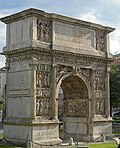Description
The theatre has a semicircular plan with a diameter of 90 meters: it could originally house some 10,000/15,000 spectators.
The exterior had 25 arcades on three orders, of which only the lower one remain, with Tuscan columns (these gave access to the interior alternatively through corridors and stairs) and part of the second one.
The cavea has mostly survived. The large scene features remains of three monumental gates which led to the orchestra; at the latter's side are the remains of the parodoi, of which the right one has kept the pavement mosaic and the polychrome marble walls, which likely characterized most of the theatre originally. Above this hall, in the 18th century, the small church of Santa Maria della Verità was built. Behind the scene, three staircases led to a lower level, which was perhaps used an entrance for artists.
The entrance alley is decorated by masks similar to those used by the actors. Some edifices around the theatre which are still under excavation included perhaps a dancing school and an association of artists.
This page is based on this
Wikipedia article Text is available under the
CC BY-SA 4.0 license; additional terms may apply.
Images, videos and audio are available under their respective licenses.



